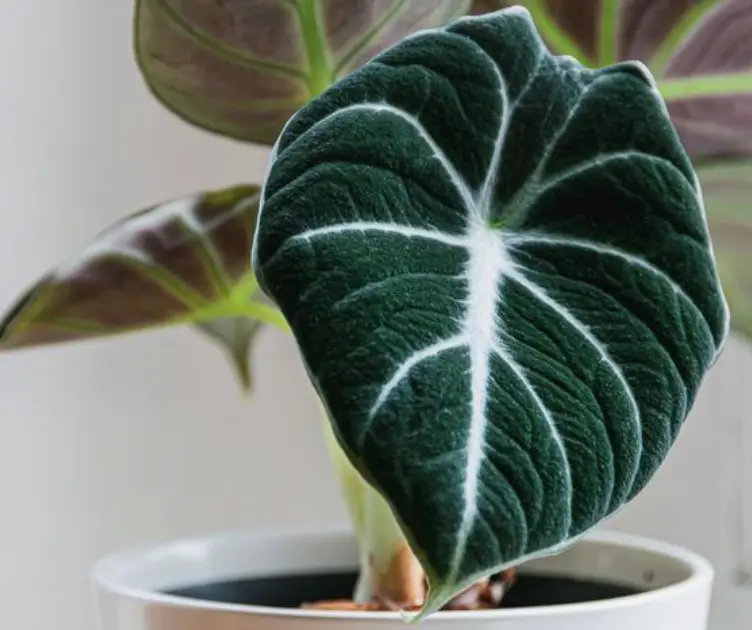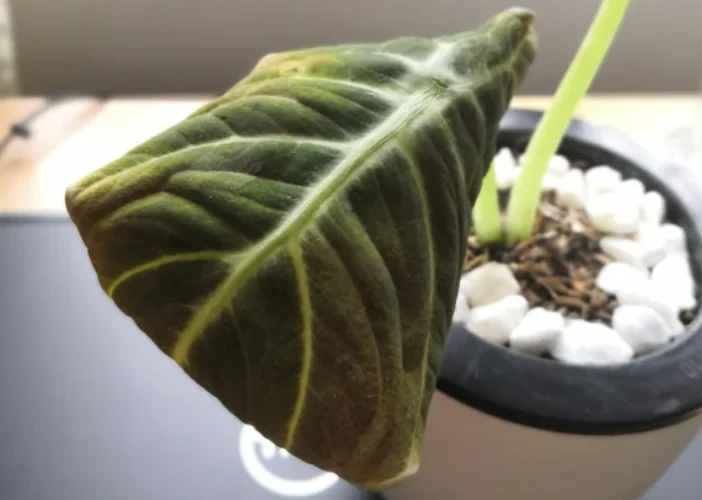Alocasia black velvet leaves curling [5 effective solutions]
Are your alocasia black velvet leaves turning yellow and showing leaf curling symptoms? You are in the right place.
If your black velvet’s leaves are turning yellow and curling downwards, the possible causes may be low humidity, underwatering, nutrient deficiency, low lighting condition, temperature stress, pests, and diseases. But by ensuring the best environment for this little queen, you will be able to enjoy its beauty for a long period.
Hopefully, this article will provide you with a detailed explanation of these causes and how to fix them. Take the time to read through it and you will be able to grow a healthy alocasia plant in the long run.
Origin and distribution
Alocasia black velvet was first collected in the 1860s by curious Englishmen who were wandering, looking for exceptional, interesting plants, in the jungles of Borneo, Southeast Asia. It is one of several species of native Alocasias.
It is also commonly known as The Little Queen or Black Velvet Elephant ears.
Now it is widely used as an ornamental plant all over the world.
Structure and appearance
Plant size: Alocasia black velvet has an interesting branched, rhizomatous structure that is usually about 30 to 40 centimeters high but its stem can produce plants as wide as 18 inches.
Leaf: Its leaves are brittle and look like beautiful ovals resembling a heart’s shape. The leaves are black and velvety on top which is contrasted beautifully by the piercing white venation and has a purplish undersurface giving it a stunning, elegant overall look.

Black Velvet Overview
| Plant type | Foliage |
| Height | 10-18 inches |
| Width | 18 inches |
| Leaf | black and velvety contrasted white venation |
| Propagule | Rhizomes |
Why does it look black?
Alocasia black velvet is so attractively black because its leaves absorb light energy across the visible spectra. This means that they do not reflect any light. Besides, the veins of this plant reflect almost all of the visible spectra producing the black-on-white contrast of the leaves. Isn’t it interesting!
Even more interesting is that when you crush the leaf open, the typical green chlorophyll comes out.
How do differentiate between a healthy and diseased plant?
Black velvet has black and velvety leaves on top which are contrasted beautifully by the piercing white venation and have a purplish undersurface.
To identify diseased ones check the color of the leaves and make sure there are no brown spots anywhere. Also, notice any curling or drooping as that may be a result of improper care or an underlying disease.


Alocasia black velvet leaf curling
A very common problem is yellow leaf curling. The probable reason for curling leaves is too much water. If the lower leaves curl under, monitor the amount of water you’re giving your plant. Also, note how often you’re watering it. The soil should not be soggy. There should be a good drainage system.
Causes and solutions to alocasia black velvet leaf curling
As a commonly grown indoor plant, Alocasia reginula ‘Black Velvet’ will comfortably grow in most household conditions. But problems can be faced while growing this little queen. Alocasia black velvet leaf curling is one of those. The probable causes of alocasia black velvet leaf curling and its remedy are discussed below:
Underwatering and overwatering stress
Alocasia plants are tropical plants and need plenty of moisture to survive. Proper watering and moisture regulation are vital parts of alocasia plant care routines.
If black velvet leaves are curling downwards, it could be due to underwatering or overwatering issues.
what to do?
Insert your index finger into the potting mix to determine the soil moisture level.
Water the plant and drain out excess water. Too much moisture will cause root rot, and the black velvet leaves will turn yellow in the long run.
Over-fertilization
Growing black velvet plants in containers will need fertilizer. Fertilization helps it to thrive and grow to its full potential. But black velvet plants are not heavy feeders like other houseplants. It would be best to play safe to avoid over-fertilization.
What to do?
It is recommended to fertilize the plant once or twice a month during the growing season. Black velvet usually goes dormant in winter and will not utilize the nutrients after fertilization.
Soil condition
Using a substrate with good drainage is important to prevent this plant from developing black velvet leaf curling. This plant is susceptible to root rot and does not like to sit in wet soil.
What to do?
The soil for black velvet should be coarse well-draining soil. Opting for a granular mix high in orchid bark and sand will help to provide the necessary drainage and root aeration, and you can supplement with additional perlite or vermiculite as necessary.
A mixture of these will create soil that will help to avoid any soggy or moist conditions.
Repotting
Black velvet is a slow grower. So, you don’t need to repot too often. This could mean repotting the plant once every 1–3 years. But remember it will often reach a maximum size of 10-18 inches wide and tall; keep that in mind when considering what size pot to use for your little queen.
Temperature and humidity
If black velvet is exposed to cooler temperatures, it will go dormant until the temperature is increased.
The best temperature to maintain for the black velvet ranges between 59°F and 80°F.
The black velvet needs a humid environment (ideally 65% or more), and misting should not be the only way you provide humidity, placing a pebble tray nearby is a good way to increase the humidity around the plant consistently. The preferred levels for humidity are between 60%-75%.
Light
Found on the jungle floors of its native countries, Alocasia black velvet loves to bask in the dappled sunlight that’s able to break through the canopy.
In the home, this means Alocasia black velvet will thrive in a bright spot with lots of indirect light.
North-facing windows are a good bet for guaranteed indirect light, but East-facing can work too as long as the morning sunlight isn’t too strong. It is possible to sustain lower light environments, but without enough light, it may go dormant.
Pruning
Alocasia black velvet requires only minimal pruning, mostly through the removal of any dead or yellowing leaves. If you wish, you may choose to remove any of the lower leaves to maintain the shape or appearance that you prefer.
In addition, due to the texture of the leaves, it is necessary to check the leaves for dust and debris. Wipe off the leaves of your little queen with a damp cloth.
At a glance,
| Soil | coarse, well-draining soil |
| Watering | Infrequent, moderate moisture, preferably once a week |
| Temperature | 55-86°F (12-30°C) |
| Sunlight | Bright indirect light |
| Humidity | Medium – high humidity (40-70%) |
FAQ
How can I identify a healthy black velvet plant?
Black velvets have brittle leaves that look like beautiful ovals resembling a heart’s shape. It has black and velvety leaves on top which are contrasted beautifully by the piercing white venation and have a purplish undersurface.
Does yellow leaf curling recover?
No, if the leaves have turned yellow, almost jaundice-looking, they’ll not go back to being green. The best thing to do now is to cut these leaves off and take the necessary measures to prevent them.
Does yellow leaf curling cause death?
The probable cause of yellow leaf curling is underwatering and too much light, therefore maintaining optimum growth conditions, one can grow his little queen beautifully.
Final thoughts
The most common cause of yellowing and curling of leaves among alocasia plants is an overwatering issue. Other possible causes are low lighting conditions, old age, pests and diseases. To avoid black velvet yellow leaf curling, some guidelines have been provided in this article.
Make sure you are following these guidelines when caring for your alocasia black velvet to ensure that you are providing the best environment for your plant. With proper care taken, you will be able to enjoy the beauty of your little queen for a long time.

![How to Get Rid of Maple Tree Helicopters?- [!Explained]](https://diaryforgardening.com/wp-content/uploads/2022/02/How-to-get-rid-of-Maple-Tree-Helicopters.jpg)


![Do Deer Eat Coleus? [!Fun Facts Explained]](https://diaryforgardening.com/wp-content/uploads/2022/02/Do-Deer-eat-Coleus.jpg)
![Why are My Golden Pothos Leaves Turning Yellow? – [!Fix Now]](https://diaryforgardening.com/wp-content/uploads/2022/02/Golden-Pothos-Leaves-Turning-Yellow.jpg)

